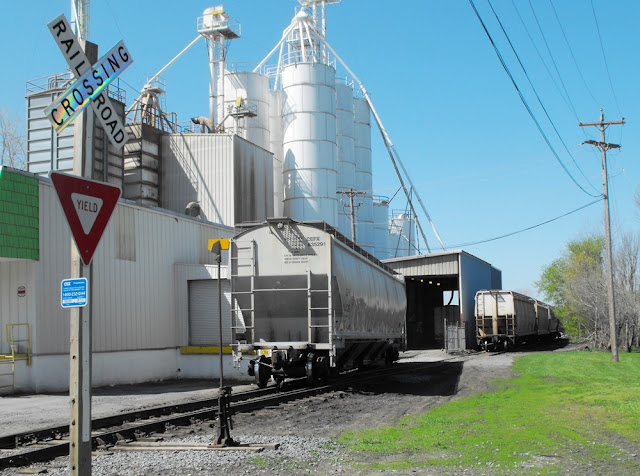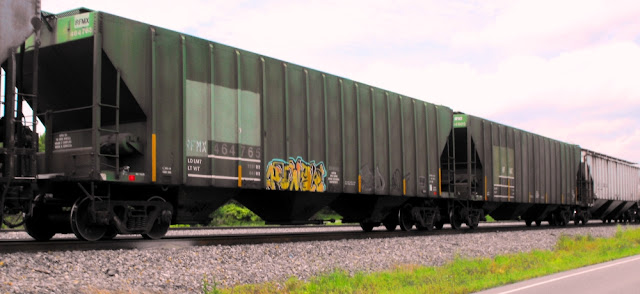The eight steps of Portage la Prairie layout planning have led us to...the trackplan. In 1986, CN 9627-5135 led lumber empties west at the UGG/storage track switch. The Cominco Elevator shed, arena, Tupper Street overpass and UGG elevator with grain cars complete the scene. Now what? Seven more steps:
STEP 1 - SIGNATURE SCENES SCHEMATIC
On a blank piece of paper, with the major streets that I'd use in each trackplan (Eighth St NW, Tupper Street overpass and Third Street NE) as benchmarks. I wrote down each signature scene I wanted to include in each trackplan: interchange, diamond, industry spur, building or other specific track in its relative location, plus a tick-box to check off once it had been included:
STEP 2 - PLAN 1.0
Following on from my earlier schematics and adding signature scenes, this was my first draft of a comprehensive trackplan for Portage. For each railway, I included two mainlines, a switching lead, spurs and three triangle-shaped 'fissible points'. The latter are: West Tower, Manitoba Pool 'B' elevator and the CN-CP interchange. These three points become important to include if the plan undergoes fission (splits) into CN or CP.
Also to be included in all track plans are 1980's-era east-to-west points for CN or CP:
CN:
-2 or 3-track yard
-ramp track within yard
-bulk fuel dealer track
-team track opposite station
-United Grain Growers elevator
CP:
-McCallister Pea & Seed (or McCain frozen foods)
-team track
-North American Can of Canada warehouse and engine track opposite station
-Engro fertilizer shed
-Manitoba Pool 'A'
-Campbell's Soup west of Eighth Street
STEP 3 - PLAN 2.0
Each railway has one mainline at east and west ends, with the second mainline ending at East Tower or diverging at West Tower: CN's to the VIA connecting track or CP's to the Carberry Sub respectively. CP has a storage track for freight or Service cars, while CN's storage track is combined with the UGG spur it was adjacent to.
Although I needed crossovers for switching purposes, I included as few as possible. Some switching at the west end will require mainline crossover moves between tracks. CP's trip to Campbell's will be facing-point switched instead of the prototype's trailing-point. I considered flipping CN's team track north of the lead, but kept it in its prototype location. There's something cool about running a complete freight train around one car in its way! I combined CP's team track with its nearby industry using a switchback. The northernmost yard tracks will function as switching leads for each railway.
STEP 4 - PLAN 3.0
Remember how I wanted to maintain the length and proportion of Portage? I settled on a 24x3 foot layout, then tried to include all the above trackage and signature scenes. I wanted to avoid a log-pile (linear version of a spaghetti-bowl layout). It looks do-able on paper, but I needed to test-fire it. I used the untried and unlikely DBS (Driveway Bed Sheets) method. I spread old bedsheets that we ust as painting dropcloths on our driveway to create a 24x3 foot layout planning space.
I brought up a six-inch bundle of flextrack, a box of turnouts, a box of snaptrack and structures from my railway room to represent three grain elevators, two stations, the fuel dealer and Campbell's Soup. In less than an hour I had a finished trackplan mockup. It became apparent that to save space, CP's McCallister, North American Can and possibly Campbell's , and CN's UGG elevator and fuel dealer could be represented by structure flats. Another alternative would be to 'bend' trackwork around structures to make room for the trackage. Overall, I was pleased that this trackplan would actually fit - in about 2,000 HO scale linear feet. The views from West tower (above) and East Tower (below) show the DBS method:
Detail views follow, looking from south to north. West Tower includes Campbell's Soup, the VIA connecting track from CP to CN, the start of the spurs, storage tracks and switching leads and MPE 'A':
The mid-section spreads out to include MPE 'B' (top) and UGG (bottom) elevators, both stations, CN's team track, fuel dealer and ramp:
The next-eastern section includes yard trackage and the interchange (centre):
And at East Tower, CP's team track and McCallister are at top while the mainlines rejoin and diverge:
In all trackplans, the cross-streets are shown as thicker lines, with trackage being the thinner lines with signature scenes labelled.
STEP 5 - PLAN 3.1
While 24x3 feet was a reasonable size layout for this prototype, I wanted a non-linear shape (L-shape) that could occupy a smaller, 12-foot square room, with additional staging potential, or for inclusion in an O-shaped layout. I bent Plan 3.0 90 degrees, with the 'hinge' area between Third ST and Tupper St. This bend would affect radius for passenger train operation, as well as the CN team track. If continuous operation is desired, the mainlines can be creatively bent at the east and west layout ends.
STEP 6 - PLAN 3.2
I'd always intended to split the layout into CN and CP halves. Although a long 24x2 foot layout could be planned for CN or CP, it seemed to me that more modellers would find a shorter 12x3 foot trackplan more useful. Plan 3.2 is CN-only, with all three fissible zones at layout's edge. All industries are still included, the yard is stub-ended with an optional crossover added. Two road crossings are included for orientation purposes, and the Tupper Street overpass could be added. Mainlines can lead to staging, or this can be a fun-to-run switching layout!
STEP 7 - PLAN 3.3
Plan 3.3 is CP-only, also measuring 12x3 feet. The storage track and team tracks could still be added if desired. As with CN, Plan 3.3 could have staging added or remain a stand-alone layout.
These plans can be further refined, redrawn, revised or otherwise enhanced as desired. Though Portage does not have an over-abundance of lineside structures seen in more urban settings, motor car sheds, houses, the arena, water tower and various sheds and garages could be modelled as structures, flats or photo backdrops.
I've seen lots of photos of layouts using the Rix Highway overpass, which is used as a view block to separate scenes. Portage actually had Tupper Street's overpass that could be modelled as a great trainwatching spot, though I had to omit it from the smallest layout plans. Gravel roads and a plethora of trackside details would enhance the layout as well. On September 20, 1985 CN 5088-5055 lead a 40-foot grain boxcars and an 86-foot hicube boxcar in a westbound freight also at the UGG/storage track switch at sunset. In the next post, we'll look at operations and structures to bring these trackplans to life.
I've seen lots of photos of layouts using the Rix Highway overpass, which is used as a view block to separate scenes. Portage actually had Tupper Street's overpass that could be modelled as a great trainwatching spot, though I had to omit it from the smallest layout plans. Gravel roads and a plethora of trackside details would enhance the layout as well. On September 20, 1985 CN 5088-5055 lead a 40-foot grain boxcars and an 86-foot hicube boxcar in a westbound freight also at the UGG/storage track switch at sunset. In the next post, we'll look at operations and structures to bring these trackplans to life.
Running extra...
Another Portage-prototype modeller is Randy O'Brien of Niagara Falls, ON. Randy added to my early west-end schematic and has produced his own design sketch, mockup, trackplan, some impressive benchwork and some impressive recent updates. Randy also shares some of his elevator construction here. John Longhurst recently travelled west through Portage on VIA train No 1. Manny Jacob snapped his train from the Tupper Street overpass, and his photos show how the Portage sightlines have improved with the eradication of almost all trackside structures.
I really shouldn't be surprised by the interest in Portage la Prairie modelling, but I am. Portage is definitely a Canadian hotspot worthy of 'fanning and modelling. Be sure to check out my 'Railfanning and Modelling Portage la Prairie' posts in the right sidebar. Though I wallow in 1980's nostalgia, rest assured that heavy tonnage still rolls.
I just finished listening to Escape from Camp 14 by Blaine Harden. The harrowing tale of the life and subsequent escape from one of the few North Koreans born in a detention camp, Shin Donghyuk. The story helps us understand the mindset of the Kim dynasty, bizarre though it may be, as well as the incredibly strong will to live that we all possess.














































